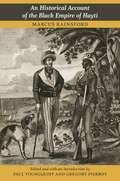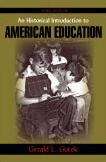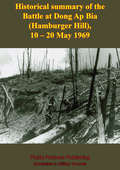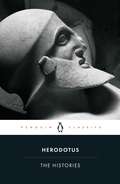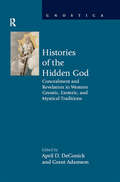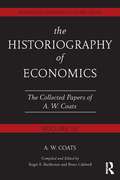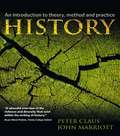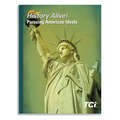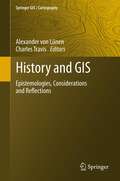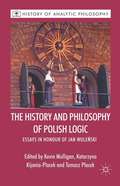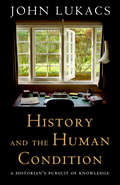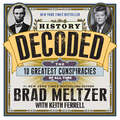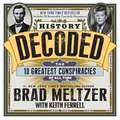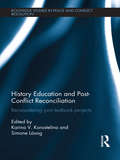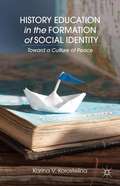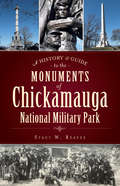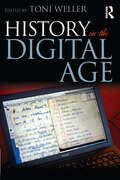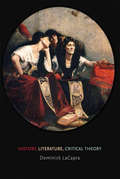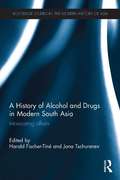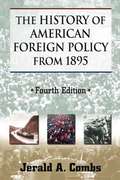- Table View
- List View
An Historical Account of the Black Empire of Hayti
by Rainsford Marcus Youngquist Paul Pierrot GrégoryAs the first complete narrative in English of the Haitian Revolution, Marcus Rainsford's An Historical Account of the Black Empire of Hayti was highly influential in establishing nineteenth-century world opinion of this momentous event. This new edition is the first to appear since the original publication in 1805. Rainsford, a career officer in the British army, went to Haiti to recruit black soldiers for the British. By publishing his observations of the prowess of black troops, and recounting his meetings with Toussaint Louverture, Rainsford offered eyewitness testimonial that acknowledged the intelligence and effectiveness of the Haitian rebels. Although not an abolitionist, Rainsford nonetheless was supportive of the independent state of Haiti, which he argued posed no threat to British colonial interests in the West Indies, an extremely unusual stance at the time. Rainsford's account made an immediate impact upon publication; it was widely reviewed, and translated twice in its first year. Paul Youngquist's and Grégory Pierrot's critical introduction to this new edition provides contextual and historical details, as well as new biographical information about Rainsford. Of particular interest is a newly discovered miniature painting of Louverture attributed to Rainsford, which is reproduced along with the twelve engravings that accompanied his original account.
An Historical Introduction To American Education (Third Edition)
by Gerald L. GutekAn Historical Introduction to American Education after several years of teaching American Education in the teacher education program at Loyola University Chicago. The course examined selected topics in the his¬tory of American education as an introduction to contemporary units on organization and governance of schools, curriculum and instruction, and educational issues. <p><p> The Third Edition features two new chapters, "Progressive Education and John Dewey" and "Immigration, Multiculturalism, and Education," as well as new primary source selections from Benjamin Rush, Horace Mann, Maria Montessori, W. E. B. Du Bois, John Dewey, and Jane Addams. Like the two earlier editions, the Third Edition takes a topical approach. Each topic is selected for its importance in introducing students to the develop¬ment of an institution or movement that has had a significant and continuing impact on American education. Together, the chapters provide an introduc¬tion to the history of American education and, importantly, examine the his¬torical foundations of contemporary areas in education like the organization and structure of educational institutions, educational theories, and multicul¬tural education.
Historical Linguistics
by Don Ringe Joseph F. EskaBringing the advances of theoretical linguistics to the study of language change in a systematic way, this innovative textbook demonstrates the mutual relevance of historical linguistics and contemporary linguistics. Numerous case studies throughout the book show both that theoretical linguistics can be used to solve problems where traditional approaches to historical linguistics have failed to produce satisfying results, and that the results of historical research can have an impact on theory. The book first explains the nature of human language and the sources of language change in broad terms. It then focuses on different types of language change from contemporary viewpoints, before exploring comparative reconstruction - the most spectacular success of traditional historical linguistics -and the problems inherent in trying to devise new methods for linguistic comparison. Positioned at the cutting edge of the field, the book argues that this approach can and should lead to the re-integration of historical linguistics as one of the core areas in the study of language.
Historical Summary Of The Battle At Dong Ap Bia (Hamburger Hill), 10-20 May 1969
by AnonIncludes 14 maps and diagrams.The battle at Dong Ap Bia (Hamburger Hill) occurred during Operation APACHE SNOW, a XXIV Corps directed operation in the Northern Ashau Valley. This operation was initiated on 10 May 1969 with the specific purpose of destroying North Vietnamese Army (NVA) and Viet Cong (VC) forces believed to be grouping in the Ashau Valley, blocking enemy routes of egress into Laos, interdicting enemy lines of communication and locating and destroying known enemy caches. Allied forces participating in the operation consisted of elements of the 101st Airborne Division, 3d Marine Division, and the 1st ARVN Division. Table of contents includes a background, the Battle at Dong Ap Bia (fire support, enemy losses, and U.S. casualties summaries), consideration of allegations by Senator Stephen M. Young, and a draft insert for congressional record.
The Histories
by Herodotus'The first example of non-fiction, the text that underlies the entire discipline of history ... it is above all a treasure trove' Tom HollandOne of the masterpieces of classical literature, The Histories describes how a small and quarrelsome band of Greek city states united to repel the might of the Persian empire. But while this epic struggle forms the core of his work, Herodotus' natural curiosity frequently gives rise to colourful digressions - a description of the natural wonders of Egypt; tales of lake-dwellers, dog-headed men and gold-digging ants. With its kaleidoscopic blend of fact and legend, The Histories offers a compelling Greek view of the world in the fifth century BC, in Aubrey de Sélincourt's elegant and celebrated translation.Translated by AUBREY DE SÉLINCOURT Revised with an Introduction and notes by JOHN MARINCOLA
Histories of the Hidden God: Concealment and Revelation in Western Gnostic, Esoteric, and Mystical Traditions (Gnostica)
by April D. Deconick Grant AdamsonIn Western religious traditions, God is conventionally conceived as a humanlike creator, lawgiver, and king, a being both accessible and actively present in history. Yet there is a concurrent and strong tradition of a God who actively hides. The two traditions have led to a tension between a God who is simultaneously accessible to humanity and yet inaccessible, a God who is both immanent and transcendent, present and absent. Western Gnostic, esoteric, and mystical thinking capitalizes on the hidden and hiding God. He becomes the hallmark of the mystics, Gnostics, sages, and artists who attempt to make accessible to humans the God who is secreted away. 'Histories of the Hidden God' explores this tradition from antiquity to today. The essays focus on three essential themes: the concealment of the hidden God; the human quest for the hidden God, and revelations of the hidden God.
The Historiography of Economics: British and American Economic Essays, Volume III (British and American Economic Essays)
by A.W. Bob CoatsThis is the third and final volume of collected papers of A.W. Bob Coats. Coats began to collect material for this volume in the years following the publication of the second volume in 1993, but sadly died in 2007, before the work was completed. The volume has now been completed under the editorship of Roger Backhouse and Bruce Caldwell. Along with his articles, the compilation of the volume also reflects Coats’ interest in and commitment to book reviews, a selection of which have been chosen for inclusion. The book also includes a comprehensive bibliography. In addition to a preface by Backhouse and Caldwell, the volume also reproduces the obituary that was published in History of Political Economy, a memoir published in 1996, and an interview with Grant Fleming, published the previous year. Together, the introductory materials, articles and reviews serve as a fitting tribute to the body of work of Bob Coats.
History: An Introduction to Theory, Method and Practice
by Peter Claus John MarriottWhy should history students care about theory? What relevance does it have to the "proper" role of the historian? Historiography and historical theory are often perceived as complex subjects, which many history students find frustrating and difficult. Philosophical approaches, postmodernism, anthropology, feminism or Marxism can seem arcane and abstract and students often struggle to apply these ideas in practice. Starting from the premise that historical theory and historiography are fascinating and exciting topics to study, Claus and Marriott guide the student through the various historical theories and approaches in a balanced, comprehensive and engaging way. Packed with intriguing anecdotes from all periods of history and supported by primary extracts from original historical writings, History: An Introduction to Theory, Method and Practice is the student-friendly text which demystifies the subject with clarity and verve. Key features - Written in a clear and witty way. Presents a balanced view of the subject, rather than the polemical view of one historian. Comprehensive - covers the whole range of topics taught on historiography and historical theory courses in suitable depth. Full of examples from different historical approaches - from social, cultural and political history to gender, economic and world history Covers a wide chronological breadth of examples from the ancient and medieval worlds to the twentieth century. Shows how students can engage with the theories covered in each chapter and apply them to their own studies via the "In Practice" feature at the end of each chapter. Includes "Discussion Documents" - numerous extracts from the primary historiographical texts for students to read and reflect upon.
History 3 Student Guide Part 1
by K12 Inc.This 3rd Grade History course traverses history from the Stone Age to the Space Age. Throughout this course, third grade students will explore the Renaissance, journey through the Age of Exploration, get to know the Maya, Aztecs, and Incas, visit civilizations in India, Africa, China, and Japan, and learn about the American Revolution and Colonial America.
History 3 Student Guide Part 2
by K12 StaffThe unit titles are: Looking East: Ottomans and Mughals; Africa, China, and Japan; England's Golden Age and Beyond; The America They Found and Founded; Graphs, Timelines, and Geography Review; The American Revolution
History 4: Student Guide, Part 2
by K12"Every so often, human history seems to take a great leap forward. Suddenly people are able to do things they have never done before. They see their world in a whole new light. The late nineteenth and early twentieth centuries were such a time. In Europe and in the United States, people had invention fever. They sped up communication and transportation. They figured out new ways to cure diseases and to link the seas. It was an age of confidence. ""Can do!"" was the attitude. ""We can figure it out. We can make it happen."" Great optimism marked the age, and people went further than ever before. Let's remember some of their achievements. Every so often, human history seems to take a great leap forward. Suddenly people are able to do things they have never done before. They see their world in a whole new light. The late nineteenth and early twentieth centuries were such a time. In Europe and in the United States, people had invention fever. They sped up communication and transportation. They figured out new ways to cure diseases and to link the seas. It was an age of confidence. ""Can do!"" was the attitude. ""We can figure it out. We can make it happen."" Great optimism marked the age, and people went further than ever before. Let's remember some of their achievements. Every so often, human history seems to take a great leap forward. Suddenly people are able to do things they have never done before. They see their world in a whole new light. The late nineteenth and early twentieth centuries were such a time. In Europe and in the United States, people had invention fever. They sped up communication and transportation. They figured out new ways to cure diseases and to link the seas. It was an age of confidence. ""Can do!"" was the attitude. ""We can figure it out. We can make it happen."" Great optimism marked the age, and people went further than ever before. Let's remember some of their achievements. Every so often, human history seems to take a great leap forward. Suddenly people are able to do things they have never done before. They see their world in a whole new light. The late nineteenth and early twentieth centuries were such a time. In Europe and in the United States, people had invention fever. They sped up communication and transportation. They figured out new ways to cure diseases and to link the seas. It was an age of confidence. ""Can do!"" was the attitude. ""We can figure it out. We can make it happen."" Great optimism marked the age, and people went further than ever before. Let's remember some of their achievements. "
History Alive! Pursuing American Ideals
by Diane HartHistory Alive! Pursuing American Ideals centers on the five founding ideals from the Declaration of Independence: equality, rights, liberty, opportunity, and democracy. Each generation has struggled with these ideals. Some have made little progress toward achieving them. Others have made great progress. This book invites students to become engaged in this struggle, from establishing an American republic to the making of modern America.
History and GIS: Epistemologies, Considerations and Reflections
by Alexander Von Lünen Charles TravisGeographical Information Systems (GIS) - either as "standard" GIS or custom made Historical GIS (HGIS) - have become quite popular in some historical sub-disciplines, such as Economic and Social History or Historical Geography. "Mainstream" history, however, seems to be rather unaffected by this trend. More generally speaking: Why is it that computer applications in general have failed to make much headway in history departments, despite the first steps being undertaken a good forty years ago? With the "spatial turn" in full swing in the humanities, and many historians dealing with spatial and geographical questions, one would think GIS would be welcomed with open arms. Yet there seems to be no general anticipation by historians of employing GIS as a research tool. As mentioned, HGIS are popular chiefly among Historical Geographers and Social and Economic Historians. The latter disciplines seem to be predestined to use such software through the widespread quantitative methodology these disciplines have employed traditionally. Other historical sub-disciplines, such as Ancient History, are also very open to this emerging technology since the scarcity of written sources in this field can be mitigated by inferences made from an HGIS that has archaeological data stored in it, for example. In most of Modern History, however, the use of GIS is rarely seen. The intellectual benefit that a GIS may bring about seems not be apparent to scholars from this sub-discipline (and others). This book wants to investigate and discuss this controversy. Why does the wider historian community not embrace GIS more readily? While one cannot deny that the methodologies linked with a GIS follow geographical paradigms rather than historical ones, the potential of GIS as a 'killer application' for digital historical scholarship should be obvious. This book brings together authors from Geography and History to discuss the value of GIS for historical research. The focus, however, will not be on the "how", but on the "why" of GIS in history.
The History And Philosophy Of Polish Logic
by Kevin Mulligan Katarzyna Kijania-Placek Tomasz PlacekThe book presents the state of the art of research into the legacy of interwar Polish analytic philosophy and exemplifies different approaches to the history of philosophy. It contains discussions and reconstructions of aspects of Polish philosophy and logic as well as reactions to and developments of this tradition.
History and the Human Condition: A Historian's Pursuit of Knowledge
by John LukacsIn a career spanning more than sixty-five years, John Lukacs has established himself as one of our most accomplished historians. Now, in the stimulating book History and the Human Condition, Lukacs offers his profound reflections on the very nature of history, the role of the historian, the limits of knowledge, and more.Guiding us on a quest for knowledge, Lukacs ranges far and wide over the past two centuries. The pursuit takes us from Alexis de Tocqueville to the atomic bomb, from American &“exceptionalism&” to Nazi expansionism, from the closing of the American frontier to the passing of the modern age.Lukacs&’s insights about the past have important implications for the present and future. In chronicling the twentieth-century decline of liberalism and rise of conservatism, for example, he forces us to rethink the terms of the liberal-versus-conservative debate. In particular, he shows that what passes for &“conservative&” in the twenty-first century often bears little connection to true conservatism.Lukacs concludes by shifting his gaze from the broad currents of history to the world immediately around him. His reflections on his home, his town, his career, and his experiences as an immigrant to the United States illuminate deeper truths about America, the unique challenges of modernity, the sense of displacement and atomization that increasingly characterizes twenty-first-century life, and much more. Moving and insightful, this closing section focuses on the human in history, masterfully displaying how right Lukacs is in his contention that history, at its best, is personal and participatory.History and the Human Condition is a fascinating work by one of the finest historians of our time. More than that, it is perhaps John Lukacs&’s final word on the great themes that have defined him as a historian and a writer.
History Decoded: The 10 Greatest Conspiracies of All Time
by Brad Meltzer Keith FerrellIt's an irresistible combination: Brad Meltzer, a born storyteller, counting down the world's most intriguing unsolved mysteries. And to make this richly illustrated book even richer, each chapter invites the reader along for an interactive experience through the addition of facsimile documents—the evidence! It's a treasure trove for conspiracy buffs, a Griffin and Sabine for history lovers. <P><P>Adapted from Decoded, Meltzer’s hit show on the HISTORY network, History Decoded explores fascinating, unexplained questions. Is Fort Knox empty? Why was Hitler so intent on capturing the Roman “Spear of Destiny”? What’s the government hiding in Area 51? Where did the Confederacy’s $19 million in gold and silver go at the end of the Civil War? And did Lee Harvey Oswald really act alone? <P>Meltzer sifts through the evidence; weighs competing theories; separates what we know to be true with what’s still—and perhaps forever—unproved or unprovable; and in the end, decodes the mystery, arriving at the most likely solution. Along the way we meet Freemasons, Rosicrucians, Nazi propagandists, and the real DB Cooper. <P>At the beginning of each story is a custom-designed envelope—a faux 19th-century leather satchel, a U.S. government classified file—containing facsimiles of relevant evidence: John Wilkes Booth’s alleged unsigned will, a map of the Vatican, Kennedy’s death certificate. The whole is a riveting, interactive adventure through the compelling world of mysteries and conspiracies.
History Decoded: The 10 Greatest Conspiracies Of All Time
by Brad Meltzer Keith FerrellIt's an irresistible combination: Brad Meltzer, a born storyteller, counting down the world's most intriguing unsolved mysteries. And to make this richly illustrated book even richer, each chapter invites the reader along for an interactive experience through the addition of removable facsimile documents--the evidence! It's a treasure trove for conspiracy buffs, a Griffin and Sabine for history lovers. Adapted from Decoded, Meltzer's hit show on the HISTORY network, History Decoded explores fascinating, unexplained questions. Is Fort Knox empty? Why was Hitler so intent on capturing the Roman "Spear of Destiny"? What's the government hiding in Area 51? Where did the Confederacy's $19 million in gold and silver go at the end of the Civil War? And did Lee Harvey Oswald really act alone? Meltzer sifts through the evidence; weighs competing theories; separates what we know to be true with what's still--and perhaps forever--unproved or unprovable; and in the end, decodes the mystery, arriving at the most likely solution. Along the way we meet Freemasons, Rosicrucians, Nazi propagandists, and the real DB Cooper. Bound in at the beginning of each story is a custom-designed envelope--a faux 19th-century leather satchel, a U. S. government classified file--containing facsimiles of relevant evidence: John Wilkes Booth's alleged unsigned will, a map of the Vatican, Kennedy's death certificate. The whole is a riveting, interactive adventure through the compelling world of mysteries and conspiracies.
History Education and Post-Conflict Reconciliation: Reconsidering Joint Textbook Projects (Routledge Studies in Peace and Conflict Resolution)
by Karina V. Korostelina Simone LässigThis book analyses the role of history education in conflict and post-conflict societies, describing common history textbook projects in Europe, the Balkans, the Caucasus, the Far East and the Middle East. Ever since the emergence of the modern school system and the implementation of compulsory education, textbooks have been seen as privileged media. The knowledge they convey is relatively persistent and moreover highly selective: every textbook author must choose and omit, condense, structure, reduce, and generalize information. Within this context, history textbooks are often at the centre of interest. There are unquestionably significant differences regarding homogeneity or plurality of interpretations when concepts of history education are compared internationally. This volume conducts a comparative analysis of common history projects in different countries and provides conceptual frameworks and methodological tools for enhancing the roles of these projects in the processes of conflict prevention and resolution. This book is timely, as issues of history education in conflict and post-conflict societies are becoming more popular with the increased realisation that unresolved disagreements about historical narratives can, and often do, lead to renewed conflict or even violence. This book will be of interest to students of peace studies and conflict resolution, political science, history, sociology, anthropology, social psychology, and international relations in general.
History Education In The Formation Of Social Identity
by Karina V. KorostelinaIn order to determine how history education can be harnessed to reduce conflict attitudes and intentions and create a culture of peace, this book examines how history curricula and textbooks shape the identities of their students through their portrayals of ingroup and outgroup identity, intergroup boundaries, and value systems.
A History & Guide to the Monuments of Chickamauga National Military Park (Landmarks)
by Stacy W. ReavesThe Battle of Chickamauga was the most significant Union defeat in the western theater of the Civil War and the second-deadliest battle of the war behind only Gettysburg. Chickamauga and Chattanooga National Military Park was established in 1890, the first of America's national military parks. Immediately after the battle, both Union and Confederate soldiers sought to honor those who gave their lives, and now Chickamauga and Chattanooga are home to more than seven hundred monuments, markers and tablets commemorating those who sacrificed. And much like the soldiers who bravely fought, each monument has its own history. Join Stacy W. Reaves and photographer Jane D. Beal as they recount the history of Chickamauga Battlefield and the monuments that memorialize its history.
A History in Sum
by Steve Nadis Shing-Tung YauIn the twentieth century, American mathematicians began to make critical advances in a field previously dominated by Europeans. Harvards mathematics department was at the center of these developments. "A History in Sum "is an inviting account of the pioneers who trailblazed a distinctly American tradition of mathematics--in algebraic geometry and topology, complex analysis, number theory, and a host of esoteric subdisciplines that have rarely been written about outside of journal articles or advanced textbooks. The heady mathematical concepts that emerged, and the men and women who shaped them, are described here in lively, accessible prose. The story begins in 1825, when a precocious sixteen-year-old freshman, Benjamin Peirce, arrived at the College. He would become the first American to produce original mathematics--an ambition frowned upon in an era when professors largely limited themselves to teaching. Peirces successors--William Fogg Osgood and Maxime Bocher--undertook the task of transforming the math department into a world-class research center, attracting to the faculty such luminaries as George David Birkhoff. Birkhoff produced a dazzling body of work, while training a generation of innovators--students like Marston Morse and Hassler Whitney, who forged novel pathways in topology and other areas. Influential figures from around the world soon flocked to Harvard, some overcoming great challenges to pursue their elected calling. "A History in Sum" elucidates the contributions of these extraordinary minds and makes clear why the history of the Harvard mathematics department is an essential part of the history of mathematics in America and beyond.
History in the Digital Age
by Toni WellerThe digital age is affecting all aspects of historical study, but much of the existing literature about history in the digital age can be alienating to the traditional historian who does not necessarily value or wish to embrace digital resources. History in the Digital Age takes a more conceptual look at how the digital age is affecting the field of history for both scholars and students. The printed copy, the traditional archive, and analogue research remain key constitute parts for most historians and for many will remain precious and esteemed over digital copies, but there is a real need for historians and students of history to seriously consider some of the conceptual and methodological challenges facing the field of historical enquiry as we enter the twenty-first century. Including international contributors from a variety of disciplines - History, English, Information Studies and Archivists – this book does not seek either to applaud or condemn digital technologies, but takes a more conceptual view of how the field of history is being changed by the digital age. Essential reading for all historians.
History, Literature, Critical Theory
by Dominick LacapraIn History, Literature, Critical Theory, Dominick LaCapra continues his exploration of the complex relations between history and literature, here considering history as both process and representation. A trio of chapters at the center of the volume concern the ways in which history and literature (particularly the novel) impact and question each other. In one of the chapters LaCapra revisits Gustave Flaubert, pairing him with Joseph Conrad. Other chapters pair J. M. Coetzee and W. G. Sebald, Jonathan Littell's novel, The Kindly Ones, and Saul Friedlander's two-volume, prizewinning history Nazi Germany and the Jews. A recurrent motif of the book is the role of the sacred, its problematic status in sacrifice, its virulent manifestation in social and political violence (notably the Nazi genocide), its role or transformations in literature and art, and its multivalent expressions in "postsecular" hopes, anxieties, and quests. LaCapra concludes the volume with an essay on the place of violence in the thought of Slavoj Zizek. In LaCapra's view Zizek's provocative thought "at times has uncanny echoes of earlier reflections on, or apologies for, political and seemingly regenerative, even sacralized violence."
A History of Alcohol and Drugs in Modern South Asia: Intoxicating Affairs (Routledge Studies in the Modern History of Asia)
by Harald Fischer-Tiné Jana TschurenevAt the beginning of the 21st century, alcoholism, transnational drug trafficking and drug addiction constitute major problems in various South Asian countries. The production, circulation and consumption of intoxicating substances created (and responded to) social upheavals in the region and had widespread economic, political and cultural repercussions on an international level. This book looks at the cultural, social, and economic history of intoxicants in South Asia, and analyses the role that alcohol and drugs have played in the region. The book explores the linkages between changing meanings of intoxicating substances, the making of and contestations over colonial and national regimes of regulation, economics, and practices and experiences of consumption. It shows the development of current meanings of intoxicants in South Asia – in terms of politics, cultural norms and identity formation – and the way in which the history of drugs and alcohol is enmeshed in the history of modern empires and nation states — even in a country in which a staunch teetotaller and active anti-drug crusader like Mohandas Gandhi is presented as the ‘father of the nation’. Primarily a historical analysis, the book also includes perspectives from Modern Indology and Cultural Anthropology and situates developments in South Asia in wider imperial and global contexts. It is of interest to scholars working on the social and cultural history of alcohol and drugs, South Asian Studies and Global History.
The History of American Foreign Policy from 1895 (xx xx)
by Jerald A CombsThis important text offers a clear, concise and affordable narrative and analytical history of American foreign policy since the Spanish-American War. The book narrates events and policies but goes further to emphasize the international setting and constraints within which American policy-makers had to operate, the domestic pressures on those policy-makers, and the ideologies, preferences, and personal idiosyncrasies of the leaders themselves.
